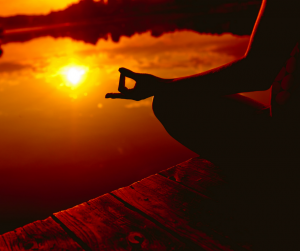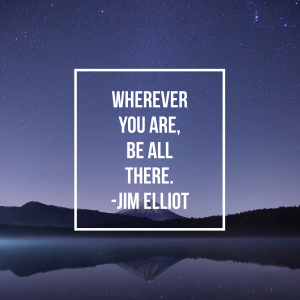I don’t know why, but I’m reluctant to admit that I meditate. It just seems so new-agey, and I am so NOT new-agey.

Because it’s not like that. The vision that you have in your head right now? Yep – nothing like that. What is it then? I guess it’s just breathing to me. But paying attention to breathing with the intent that I’m not focusing on anything else.
About once a day, (but there have been periods where I’ve totally forgotten to practice – for like weeks!) I just sit, wherever I am, and pay attention to my breathing – and then, as I’m doing it, I’ll also check in with my body.
I start with trying to match the length of my inhale and exhale. Then I’ll try to make them last to a count of 4. Sometimes, to start, I repeat, “In, two, three, four. Out, two, three, four. In, two, three, four. Out, two, three, four.” And I typically close my eyes – only because then I don’t get distracted by the shiney. “Oooh! Pink Nail Polish!”
Things that I do notice:
- Am I breathing in from my chest? Or my belly?
- As I’m breathing in, my chest feels tight – it’s more difficult to breathe in than usual.
- My exhales are short – let’s see if I can slow those down.
- I think I’ve been siting too long because my lower back feels tight.
- Random thoughts that run through my head. Like, “I need to remember to order more coffee today.”
- I’m feeling anxious. I have so much work to do. I can’t wait for this 5 minutes to be over so that I can get back to what I was doing.
- My toe is uncomfortable in these shoes.
You might be wondering, Why did I start to meditate?
I had read the book, 10% Happier, by Dan Harris; he’s a newscaster on CBS, and it starts out with him having a panic attack on air. He starts meditating as a way of reducing his stress from a very high pressure career.
In the book, he talks about reacting versus responding. And although I clearly understood the concepts, a short time later, I found myself in a crucial conversation with a client, and really didn’t like the role that I played in the conflict.
In retrospect, I’d been reactive in the conversation, instead of being in control of my emotions. I let my emotions run me instead of being thoughtful, hearing him, and acknowledging that I heard what he was saying.
I really didn’t like the way that I handled the situation. It shouldn’t have turned out the way it did, and through researching solutions, everything pointed to mindfulness training (aka: meditation).
Mindfulness
Now, mindfulness is a buzz word from 10 years ago that I kind of wish would go away. It’s got such a “woo” connotation to it.
I first was introduced to mindfulness when I started out as a health coach 10 years ago. But at the time, the only way I was able to integrate it into my life was through taste and texture. Being aware of what I was eating when I was eating it.
My mindfulness training stopped there – at my mouth. It didn’t even really travel down to my stomach – to evaluate whether I should stop eating. And it could be that I stopped applying any way other than taste and texture of food because it did seem so ‘out there’. However there was some awareness of whether I needed to eat. I had at least learned to distinguish between true hunger and cravings.
So yeah – IMO, the term ‘mindfulness’ needs a PR makeover.
So, how does meditation bridge the gap between being impulsive in eating and our actions and not?

Through paying attention to your breath & checking into your body for as short as 5 minutes a day, you start to naturally get clued in to what is happening. By learning to pay attention to how your body feels – hands sweaty, heart beating, skin hot – when you’re doing the breathing exercise, it gets easier to notice and name what you’re feeling when you’re in the middle of something.
When my hands are sweaty, my heart is beating and my skin feels hot, those are signs that I’m either angry, feeling embarrassed or shame – maybe even all three!
And what’s really interesting about that, is that once you mentally tell yourself, “I’m angry.” That feeling becomes less intense.
Naming your feelings give relief to that feeling. Try it. It works.
Now that you’re clued in to how your body is feeling physically and emotionally, you can start to do something with that information.
If you know that when you’re emotional, you gravitate to the closest available sugary goodness, then the first step to waking up elbows deep in a jar of peanut butter is being aware of your emotions.
If you know that when you feel vulnerable in conflicts with your partner, you say hurtful things, then taking a pause before you respond is probably a good technique.
And that’s exactly what meditation teaches you to do: take pause, and check in.
***
If topics like this interest you, and you want to learn more, join my mailing list HERE. I send out weekly articles that give concrete solutions to struggles that we all have.
Because if there’s something I’ve learned over the years, is that even as much as we think we’re alone in what we’re going through, chances are that others can relate and help.